Morphology, Internal Architecture, Facies Model, and Emplacement Mechanisms of Lava Flows from the Central Atlantic Magmatic Province (CAMP) of the Hartford and Deerfield Basins (USA)
Abstract
:1. Introduction
2. Geological Setting
3. Terminology and Methods
4. Results
5. Field Observations
5.1. The Talcott Basalt Formation
5.2. The Holyoke Basalt Formation
5.3. The Hampden Basalt Formation
5.4. The Deerfield Basalt Formation
6. Discussion
6.1. Emplacement Conditions and Vent Locations of the Lava Flows from the Hartford and Deerfield Basins
6.2. Volcanological Characteristics and Facies Model of CAMP Basalt of Hartford and Deerfield Basins
6.3. Cooling Duration of the Subaerial Lava Flows of the Hartford and Deerfield Basins
6.4. Comparison With Other Basins in the USA, Canada, Portugal, and Morocco
6.4.1. Newark Basin (USA)
6.4.2. Fundy Basin (CANADA)
6.4.3. Portugal: Algarve Basin (Portugal)
6.4.4. Moroccan Basins
7. Conclusions
Supplementary Materials
Author Contributions
Funding
Data Availability Statement
Acknowledgments
Conflicts of Interest
References
- Blackburn, T.J.; Olsen, P.E.; Bowring, S.A.; McLean, N.M.; Kent, D.V.; Puffer, J.; McHone, G.; Rasbury, E.T.; Et-Touhami, M. Zircon U-Pb geochronology links the end-Triassic extinction with the Central Atlantic Magmatic Province. Science 2013, 340, 941–945. [Google Scholar] [CrossRef] [PubMed]
- Davies, J.H.F.L.; Marzoli, A.; Bertrand, H.; Youbi, N.; Ernesto, M.; Greber, N.D.; Ackerson, M.; Simpson, G.; Bouvier, A.S.; Baumgartner, L.; et al. Zircon petrochronology in large igneous provinces reveals upper crustal contamination processes: New U–Pb ages, Hf and O isotopes, and trace elements from the Central Atlantic magmatic province (CAMP). Contrib. Mineral. Petrol. 2021, 176, 9. [Google Scholar] [CrossRef]
- Marzoli, A.; Bertrand, H.; Youbi, N.; Callegaro, S.; Merle, R.; Reisberg, L.; Chiaradia, M.; Brownlee, S.I.; Jourdan, F.; Zanetti, A.; et al. The Central Atlantic Magmatic Province (CAMP) in Morocco. J. Petrol. 2019, 60, 945–996. [Google Scholar] [CrossRef]
- Heimdal, T.H.; Jones, M.T.; Svensen, H.H. Thermogenic carbon release from the Central Atlantic magmatic province caused major end-Triassic carbon cycle perturbations. Proc. Natl. Acad. Sci. USA 2020, 117, 11968–11974. [Google Scholar] [CrossRef] [PubMed]
- de Oliveira, R.G.; de Medeiros, W.E.; Domingos, N.R.R.; Rodrigues, M.D.A.C. A review of the geophysical knowledge of the Borborema Province, NE-Brazil, and tectonic implications. J. South Am. Earth Sci. 2023, 126, 104360. [Google Scholar] [CrossRef]
- McHone, J.G. Non-plume magmatism and rifting during the opening of the central Atlantic Ocean. Tectonophysics 2000, 316, 287–296. [Google Scholar] [CrossRef]
- Olsen, P.E.; Kent, D.V.; Et-Touhami, M.; Puffer, J. Cyclo-, magneto-, and bio-stratigraphic constraints on the duration of the CAMP event and its relationship to the Triassic-Jurassic boundary. Geophys. Monogr. Am. Geophys. Union 2003, 136, 7–32. [Google Scholar]
- Youbi, N.; Martins, L.T.; Munhá, J.M.; Ibouh, H.; Madeira, J.; Chayeb, E.A.; El Boukhari, A. The late Triassic-early Jurassic volcanism of Morocco and Portugal in the Framework of the Central Atlantic Magmatic Province: An overview. Geophys. Monogr. Am. Geophys. Union 2003, 136, 179–208. [Google Scholar]
- Knight, K.B.; Nomade, S.; Renne, P.R.; Marzoli, A.; Bertrand, H.; Youbi, N. The Central Atlantic Magmatic Province at the Triassic–Jurassic boundary: Paleomagnetic and 40Ar/39Ar evidence from Morocco for brief, episodic volcanism. Earth Planet. Sci. Lett. 2004, 228, 143–160. [Google Scholar] [CrossRef]
- Marzoli, A.; Bertrand, H.; Knight, K.B.; Cirilli, S.; Buratti, N.; Vérati, C.; Nomade, S.; Renne, P.R.; Youbi, N.; Martini, R.; et al. Synchrony of the Central Atlantic magmatic province and the Triassic-Jurassic boundary climatic and biotic crisis. Geology 2004, 32, 973–976. [Google Scholar] [CrossRef]
- Tegner, C.; Michelis, S.A.; McDonald, I.; Brown, E.L.; Youbi, N.; Callegaro, S.; Lindström, S.; Marzoli, A. Mantle dynamics of the Central Atlantic Magmatic Province (CAMP): Constraints from platinum group, gold and lithophile elements in flood basalts of Morocco. J. Petrol. 2019, 60, 1621–1652. [Google Scholar] [CrossRef]
- Whiteside, J.H.; Olsen, P.E.; Kinney, S.T.; Et-Touhami, M. Platinum Group Element Traces of CAMP Volcanism Associated with Low-Latitude Environmental and Biological Disruptions. Large Igneous Prov. A Driv. Glob. Environ. Biot. Chang. 2021, 263–304. [Google Scholar] [CrossRef]
- Bertrand, H.; Fornari, M.; Marzoli, A.; García-Duarte, R.; Sempere, T. The Central Atlantic magmatic province extends into Bolivia. Lithos 2014, 188, 33–43. [Google Scholar] [CrossRef]
- Callegaro, S.; Marzoli, A.; Bertrand, H.; Blichert-Toft, J.; Reisberg, L.; Cavazzini, G.; Jourdan, F.; Davies, J.H.; Parisio, L.; Bouchet, R.; et al. Geochemical constraints provided by the Freetown Layered Complex (Sierra Leone) on the origin of high-Ti tholeiitic CAMP magmas. J. Petrol. 2017, 58, 1811–1840. [Google Scholar] [CrossRef]
- Deckart, K.; Clark, A.H.; Celso, A.A.; Ricardo, V.R.; Bertens, A.N.; Mortensen, J.K.; Fanning, M. Magmatic and hydrothermal chronology of the giant Río Blanco porphyry copper deposit, central Chile: Implications of an integrated U-Pb and 40Ar/39Ar database. Econ. Geol. 2005, 100, 905–934. [Google Scholar] [CrossRef]
- Merle, R.; Marzoli, A.; Bertrand, H.; Reisberg, L.; Verati, C.; Zimmermann, C.; Chiaradia, M.; Bellieni, G.; Ernesto, M. 40Ar/39Ar ages and Sr–Nd–Pb–Os geochemistry of CAMP tholeiites from Western Maranhão basin (NE Brazil). Lithos 2011, 122, 137–151. [Google Scholar] [CrossRef]
- Merle, R.; Marzoli, A.; Reisberg, L.; Bertrand, H.; Nemchin, A.; Chiaradia, M.; Callegaro, S.; Jourdan, F.; Bellieni, G.; Kontak, D.; et al. Sr, Nd, Pb and Os isotope systematics of CAMP tholeiites from Eastern North America (ENA): Evidence of a subduction-enriched mantle source. J. Petrol. 2014, 55, 133–180. [Google Scholar] [CrossRef]
- Oyarzun, R.; Doblas, M.; López-Ruiz, J.; María Cebrá, J. Opening of the central Atlantic and asymmetric mantle upwelling phenomena: Implications for long-lived magmatism in western North Africa and Europe. Geology 1997, 25, 727–730. [Google Scholar] [CrossRef]
- Wilson, C.J.; Hildreth, W. The Bishop Tuff: New insights from eruptive stratigraphy. J. Geol. 1997, 105, 407–440. [Google Scholar] [CrossRef]
- Withjack, R.S.M.; Olsen, P.E. Relative timing of CAMP, rifting, continental breakup, and basin inversion: Tectonic significance. In The Central Atlantic Magmatic Province, Insights from Fragments of Pangea; Hames, W.E., McHone, J.G., Renne, P.R., Ruppel, C., Eds.; Geophysical Monograph Series; American Geophysical Union: Washington, DC, USA, 2003; Volume 136, pp. 33–59. [Google Scholar] [CrossRef]
- Van de Schootbrugge, B.; Quan, T.M.; Lindström, S.; Püttmann, W.; Heunisch, C.; Pross, J.; Fiebig, J.; Petschick, R.; Röhling, H.G.; Richoz, S.; et al. Floral changes across the Triassic/Jurassic boundary linked to flood basalt volcanism. Nat. Geosci. 2009, 2, 589–594. [Google Scholar] [CrossRef]
- Olsen, P.E.; Kent, D.V.; Cornet, B.; Witte, W.K.; Schlische, R.W. High-resolution stratigraphy of the Newark rift basin (early Mesozoic, eastern North America). Geol. Soc. Am. Bull 1996, 108, 40–77. [Google Scholar] [CrossRef]
- Kent, D.V.; Olsen, P.E. Early Jurassic magnetostratigraphy and paleolatitudes from the Hartford continental rift basin (eastern North America): Testing for polarity bias and abrupt polar wander in association with the central Atlantic magmatic province. J. Geophys. Res. Solid Earth 2008, 113. [Google Scholar] [CrossRef]
- Kent, D.V.; Olsen, P.E.; Muttoni, G. Astrochronostratigraphic polarity time scale (APTS) for the Late Triassic and Early Jurassic from continental sediments and correlation with standard marine stages. Earth-Sci. Rev. 2017, 166, 153–180. [Google Scholar] [CrossRef]
- Kontak, D.J. On the edge of CAMP: Geology and volcanology of the Jurassic North Mountain Basalt, Nova Scotia. Lithos 2008, 101, 74–101. [Google Scholar] [CrossRef]
- Martins, L.T.; Madeira, J.; Youbi, N.; Munhá, J.; Mata, J.; Kerrich, R. Rift-related magmatism of the Central Atlantic magmatic province in Algarve, Southern Portugal. Lithos 2008, 101, 102–124. [Google Scholar] [CrossRef]
- Meddah, A.; Bertrand, H.; Seddiki, A.; Tabeliouna, M. The Triassic-Liassic volcanic sequence and rift evolution in the Saharan Atlas basins (Algeria): Eastward vanishing of the Central Atlantic Magmatic Province. Geol. Acta. 2017, 15, 0011–0023. [Google Scholar]
- Whiteside, J.H.; Olsen, P.E.; Kent, D.V.; Fowell, S.J.; Et-Touhami, M. Synchrony between the Central Atlantic magmatic province and the Triassic–Jurassic mass-extinction event? Palaeogeogr. Palaeoclimatol. Palaeoecol. 2007, 244, 345–367. [Google Scholar] [CrossRef]
- Olsen, P.E. Stratigraphic record of the early Mesozoic breakup of Pangea in the Laurasia-Gondwana rift system. Annu. Rev. Earth Planet. Sci. 1997, 25, 337–401. [Google Scholar] [CrossRef]
- Olsen, P.E. Fossil great lakes of the Newark Supergroup in New Jersey. In Field Studies of New Jersey Geology and Guide to Field Trips: New York State Geological Association, 52nd Annual Meeting; Rutgers University: Newark, NJ, USA, 1980; pp. 352–398. [Google Scholar]
- Philpotts, A. Nature of a flood-basalt-magma reservoir based on the compositional variation in a single flood-basalt flow and its feeder dike in the Mesozoic Hartford Basin, Connecticut. Contrib. Miner. Petrol. 1988, 133, 69–82. [Google Scholar] [CrossRef]
- Whalen, L.; Gazel, E.; Vidito, C.; Puffer, J.; Bizimis, M.; Henika, W.; Caddick, M.J. Supercontinental inheritance and its influence on supercontinental breakup: The Central Atlantic Magmatic Province and the breakup of Pangea. Geochem. Geophys. Geosyst. 2015, 16, 3532–3554. [Google Scholar] [CrossRef]
- Elkins, L.J.; Meyzen, C.M.; Callegaro, S.; Marzoli, A.; Bizimis, M. Assessing origins of end-Triassic tholeiites from Eastern North America using hafnium isotopes. Geochem. Geophys. Geosyst. 2020, 21, 195–212. [Google Scholar] [CrossRef]
- Gray, N.H. Mesozoic volcanism in north central Connecticut. In Guidebook for Field Trips in Connecticut and South Central Massachusetts, 74th Annual Meeting; Joesten, R., Quarrier, S.S., Eds.; Connecticut Geology National: Hartford, CT, USA, 1982; pp. 154–196. [Google Scholar]
- Wise, D.U. Mesozoic stress history of the upper Connecticut Valley at Turners Falls, Massachusetts. In Fieldtrip Guidebook, New England Intercollegiate Geological Conference, 74th Annual Meeting; Keene, N.H., Ed.; University of New Hampshire: Durham, NC, USA, 1988; pp. 351–372. [Google Scholar]
- Manspeizer, W. Rift tectonics inferred from volcanic and clastic structures. In Field Studies of New Jersey Geology and Guide to Field Trips: New York State Geological Association, 52nd Annual Meeting; Sheridan, R.E., Grow, J.A., Eds.; Rutgers University: Newark, NJ, USA, 1980; pp. 314–350. [Google Scholar]
- Philpotts, A.R.; Skinner, B.J.; Lane, F.T. A visit to the North Branford Trap-Rock quarry operated by Tilcon Connecticut. In Guidebook for Field Trips in Connecticut State Geological and Natural History Survey of Connecticut Guidebook, 97th Annual Meeting; McHone, N.W., Peterson, M.J., Eds.; Intercollegiate Geological Conference: Boston, MA, USA, 2005; pp. 251–294. [Google Scholar]
- Olsen, P.E.; Whiteside, J.H. Jurassic cyclostratigraphy and paleontology of the Hartford basin. In Guidebook for Field Trips in Connecticut State Geological and Natural History Survey of Connecticut Guidebook, 97th Annual Meeting; McHone, N.W., Peterson, M.J., Eds.; Intercollegiate Geological Conference, Department of Geology and Geophysics, Yale University: New Haven, CT, USA, 2005; pp. A4-1–A4-51. [Google Scholar]
- Puffer, J.H.; Block, K.A.; Steiner, J.C. Transmission of flood basalts through a shallow crustal sill and the correlation of sill layers with extrusive flows: The Palisades intrusive system and the basalts of the Newark Basin, New Jersey, USA. J. Geol. 2009, 117, 139–155. [Google Scholar] [CrossRef]
- Philpotts, A.R. The Holyoke Basalt at the Tilcon Quarry, North Branford: The geology, petrology, and history of one of the world’s largest flood-basalt eruptions. In Geological Society of Connecticut Field Trip Guidebook; Peter, M.L., Margaret, A.T., Eds.; CT.GOV: Hartford, CT, USA, 2010; Volume 1, pp. 8–16, Traprock, Tracks, and Brownstone: The Geology, Paleontology and History of World-Class Sites in the Connecticut Valley. Available online: https://www.geologicalsocietyct.org (accessed on 23 May 2024).
- Puffer, J.H.; Laskowich, C. Volcanic diapirs in the Orange Mountain flood basalt: New Jersey, USA. J. Volcanol. Ggeotherm. Res. 2012, 237, 1–9. [Google Scholar] [CrossRef]
- Puffer, J.H.; Block, K.A.; Steiner, J.C.; Laskowich, C. Complex layering of the Orange Mountain Basalt: New Jersey, USA. Bull. Volcanol. 2018, 80, 54. [Google Scholar] [CrossRef]
- El Hachimi, H.; Youbi, N.; Madeira, J.; Bensalah, M.K.; Martins, L.; Mata, J.; Medina, F.; Bertrand, H.; Marzoli, A.; Munhá, J.; et al. Morphology, internal architecture and emplacement mechanisms of lava flows from the Central Atlantic Magmatic Province (CAMP) of Argana Basin (Morocco). Geol. Soc. Lond. Spec. Publ. 2012, 357, 167–193. [Google Scholar] [CrossRef]
- El Hachimi, H.; Youbi, N.; Madeira, J.; Marzoli, A.; Mata, J.; Bertrand, H.; Bensalah, M.K.; Boumehdi, M.A.; Doblas, M.; Medina, F.; et al. Physical volcanology and emplacement mechanism of the Central Atlantic Magmatic Province (CAMP) lava flows from the Central High Atlas, Morocco. Comptes Rendus Geosci. 2020, 352, 455–473. [Google Scholar] [CrossRef]
- Schlische, R.W. Anatomy and evolution of the Triassic-Jurassic continental rift system, eastern North America. Tectonics 1993, 12, 1026–1042. [Google Scholar] [CrossRef]
- Wise, D.U.; Robinson, P. Tectonics of the Mesozoic Connecticut Valley graben. Soc. Am. Abstr. Programs. 1982, 14, 96. [Google Scholar]
- Cornet, B.; Traverse, A.; McDonald, N.G. Fossil spores, pollen, and fishes from Connecticut indicate Early Jurassic age for part of the Newark Group. Science 1973, 182, 1243–1247. [Google Scholar] [CrossRef]
- Cornet, B.; Traverse, A. Palynological contributions to the chronology and stratigraphy of the Hartford Basin in Connecticut and Massachusetts. In Proceedings of the Annual Meeting, American Association of Stratigraphic Palynologists, Vol. 6, Geoscience and Man, Houston, Texas, USA, 25 April 1975; pp. 1–33. [Google Scholar] [CrossRef]
- Cornet, B.; Olsen, P.E. A summary of the biostratigraphy of the Newark Supergroup of eastern North America with comments on early Mesozoic provinciality. In Extended Abstract of III Congreso Latinoamericano de Paleontologia, Mexico; Simposio Sobre Floras Des Triasico Tardio, Su Fitogeografia y Paleoecologia, Memoria; Universidad Nacional Autonoma de Mexico: Mexico City, Mexico, 1985; pp. 67–81. [Google Scholar]
- Lucas, S.G.; Huber, P. Vertebrate biostratigraphy and biochronology of the nonmarine Late Triassic. In The Great Rift Valleys of Pangea in eastern North America; LeTourneau, P.M., Olsen, P.E., Eds.; Columbia University Press: New York, NY, USA, 2003; Volume 2, pp. 143–191. [Google Scholar]
- Olsen, P.E.; Galton, P.M. Triassic-Jurassic tetrapod extinctions: Are they real? Science 1977, 197, 983–986. [Google Scholar] [CrossRef]
- Seidemann, D.E. Age of the Triassic/Jurassic boundary; A view from the Hartford Basin. Am. J. Sci. 1989, 289, 553–562. [Google Scholar] [CrossRef]
- Jourdan, F.; Renne, P.R.; Reimold, W.U. An appraisal of the ages of terrestrial impact structures. Earth. Planet Sci. Lett. 2009, 286, 1–13. [Google Scholar] [CrossRef]
- Sutter, J.F. Innovative approaches to the dating of igneous events in the early Mesozoic basins of the eastern United States. US Geol. Surv. Bull. 1988, 1776, 194–200. [Google Scholar]
- Dunning, G.R.; Hodych, J.P. U/Pb zircon and baddeleyite ages for the Palisades and Gettysburg sills of the northeastern United States: Implications for the age of the Triassic/Jurassic boundary. Geology 1990, 18, 795–798. [Google Scholar] [CrossRef]
- Baksi, A.K. Critical Evaluation Of 40Ar/39Ar Ages for the Central Atlantic Magmatic Province: Timing, Duration and Possible Migration of Magmatic Centers. In The Central Atlantic Magmatic Province; Hames, W.E., McHone, J.G., Renne, P.R., Ruppel, C., Eds.; American Geophysical Union: Washington, DC, USA, 2003; pp. 77–90. [Google Scholar] [CrossRef]
- Philpotts, A.R.; Martello, A. Diabase feeder dikes for the Mesozoic basalts in southern New England. Am. J. Sci. 1986, 286, 105–126. [Google Scholar] [CrossRef]
- Luttrell, G.L.W. Stratigraphic nomenclature of the Newark Supergroup of eastern North America. US Geol. Surv. Bull. 1989, 1572, 136. [Google Scholar]
- Prévot, M.; McWilliams, M. Paleomagnetic correlation of Newark Supergroup volcanics. Geology 1989, 17, 1007–1010. [Google Scholar] [CrossRef]
- Tollo, R.P.; Gottfried, D. Petrochemistry of Jurassic basalt from eight cores, Newark basin, New Jersey: Implications for the volcanic petrogenesis of the Newark Supergroup. East. North Am. Mesoz. Magmat. 1992, 268, 233–259. [Google Scholar]
- Macdonald, G.A. Pahoehoe, a’a, and block lava. Am. J. Sci. 1953, 251, 169–191. [Google Scholar] [CrossRef]
- Macdonald, G.A. Forms and structures of extrusive basaltic rocks. In Basalts: The Polderva art Treatise on Rocks of Basaltic Composition; Hess, H.H., Poldervaart, A., Eds.; Interscience Publishers: New York, NY, USA, 1967; Volume 1, pp. 1–61. [Google Scholar]
- White, J.D.L.; Bryan, S.E.; Ross, P.S.; Self, S.; Thordarson, T. Physical volcanology of continental large igneous provinces: Update and review. In Studies in Volcanology: The Legacy of George Walker. Special Publications of IAVCEI, 2; Thordarson, T., Self, S., Larsen, G., Rowland, S.K., Hoskuldsson, A., Eds.; Geological Society: London, UK, 2009; pp. 291–321. [Google Scholar]
- Aubele, J.C.; Crumpler, L.S.; Elston, W.E. Vesicle zonation and vertical structure of basalt flows. J. Volcanol. Geotherm. Res. 1988, 35, 349–374. [Google Scholar] [CrossRef]
- Keszthelyi, L.; McEwen, A.S.; Thordarson, T. Terrestrial analogs and thermal models for Martian flood lavas. J. Geophys. Res. Planets 2000, 105, 15027–15049. [Google Scholar] [CrossRef]
- Keszthelyi, L. Classification of the Mafic Lava Flows from ODP Leg 183. In Proceedings of the Ocean Drilling Program, Scientific Results; Frey, F.A., Coffin, M.F., Wallace, P.J., Quilty, P.G., Eds.; University of Arizona: Tucson, AZ, USA, 2002; Volume 183, pp. 1–28. Available online: http://www-odp.tamu.edu/publications/183_SR/012/012.htm (accessed on 23 May 2024).
- Rowland, S.K.; Walker, G.P. Toothpaste lava: Characteristics and origin of a lava structural type transitional between pahoehoe and aa. Bull. Volcanol. 1987, 49, 631–641. [Google Scholar] [CrossRef]
- Self, S.; Keszthelyi, L.; Thordarson, T. The importance of pāhoehoe. Annu. Rev. Earth Planet. Sci. 1998, 26, 81–110. [Google Scholar] [CrossRef]
- Self, S.; Thordarson, T.; Keszthelyi, L. Emplacement of continental flood basalt lava flows. Geophys. Monogr.-Am. Geophys. Union 1997, 100, 381–410. [Google Scholar]
- Thordarson, T.; Self, S. The Roza Member, Columbia River Basalt Group: A gigantic pahoehoe lava flow field formed by endogenous processes? J. Geophys. Res. Solid Earth 1998, 103, 27411–27445. [Google Scholar] [CrossRef]
- Wilmoth, R.A.; Walker, G.P. P-type and S-type pahoehoe: A study of vesicle distribution patterns in Hawaiian lava flows. J. Volcanol. Geotherm. Res. 1993, 55, 129–142. [Google Scholar] [CrossRef]
- Walker, G.P. Grain-size characteristics of pyroclastic deposits. J. Geol. 1971, 79, 696–714. [Google Scholar] [CrossRef]
- Guilbaud, M.; Self, S.; Thordarson, T.; Blake, S. Morphology, surface structures, and emplacement of lavas produced by Laki, AD 1783–1784. Spec. Pap. Geol. Soc. Am. 2005, 396, 81. [Google Scholar]
- Kent, R.W.; Thomson, B.A.; Skelhorn, R.R.; Kerr, A.C.; Norry, M.J.; Walsh, J.N. Emplacement of Hebridean Tertiary flood basalts: Evidence from an inflated pahoehoe lava flow on Mull, Scotland. J. Geol. Soc. 1998, 155, 599–607. [Google Scholar] [CrossRef]
- Jerram, D.A.; Mountney, N.; Stollhofen, H. Facies architecture of the Etjo Sandstone Formation and its interaction with the Basal Etendeka Flood Basalts of northwest Namibia: Implications for offshore prospectivity. Geol. Soc. Lond. Spec. Publ. 1999, 153, 367–380. [Google Scholar] [CrossRef]
- Jerram, D.; Mountney, N.; Holzförster, F.; Stollhofen, H. Internal stratigraphic relationships in the Etendeka Group in the Huab Basin, NW Namibia: Understanding the onset of flood volcanism. J. Geodyn. 1999, 28, 393–418. [Google Scholar] [CrossRef]
- Keszthelyi, L.; Self, S.; Thordarson, T. Application of recent studies on the emplacement of basaltic lava flows to the Deccan Traps. Mem. Geol. Soc. India 1999, 43, 485–520. [Google Scholar]
- Bondre, N.R.; Duraiswami, R.A.; Dole, G. A brief comparison of lava flows from the Deccan Volcanic Province and the Columbia-Oregon Plateau Flood Basalts: Implications for models of flood basalt emplacement. J. Earth Sys. Sci. 2004, 113, 809–817. [Google Scholar] [CrossRef]
- Single, R.T.; Jerram, D.A. The 3D facies architecture of flood basalt provinces and their internal heterogeneity: Examples from the Palaeogene Skye Lava Field. J. Geol. Soc. 2004, 161, 911–926. [Google Scholar] [CrossRef]
- Waichel, B.L.; de Lima, E.F.; Lubachesky, R.; Sommer, C.A. Pahoehoe flows from the central Paraná continental flood basalts. Bull. Volcanol. 2006, 68, 599–610. [Google Scholar] [CrossRef]
- Passey, S.R.; Bell, B.R. Morphologies and emplacement mechanisms of the lava flows of the Faroe Islands Basalt Group, Faroe Islands, NE Atlantic Ocean. Bull. Volcanol. 2007, 70, 139–156. [Google Scholar] [CrossRef]
- Bondre, N.R.; Hart, W.K. Morphological and textural diversity of the Steens Basalt lava flows, Southeastern Oregon, USA: Implications for emplacement style and nature of eruptive episodes. Bull. Volcanol. 2008, 70, 999–1019. [Google Scholar] [CrossRef]
- Duraiswami, R.A.; Bondre, N.R.; Managave, S. Morphology of rubbly pahoehoe (simple) flows from the Deccan Volcanic Province: Implications for style of emplacement. J. Volcanol. Geotherm. Res. 2008, 177, 822–836. [Google Scholar] [CrossRef]
- Hon, K.E.N.; Kauahikaua, J.I.M.; Denlinger, R.; Mackay, K. Emplacement and inflation of pahoehoe sheet flows: Observations and measurements of active lava flows on Kilauea Volcano, Hawaii. Geol. Soc. Am. Bull. 1994, 106, 351–370. [Google Scholar] [CrossRef]
- Walker, G.P. “Coherent intrusion complexes” in large basaltic volcanoes—A new structural model. J. Volcanol. Geotherm. Res. 1992, 50, 41–54. [Google Scholar] [CrossRef]
- Fisher, R.V. Rocks composed of volcanic fragments and their classification. Earth-Sci. Rev. 1966, 1, 287–298. [Google Scholar] [CrossRef]
- Fisher, R.V. Proposed classification of volcaniclastic sediments and rocks. Geol. Soc. Am. Bull. 1961, 72, 1409–1414. [Google Scholar] [CrossRef]
- Manville, V.; Németh, K.; Kano, K. Source to sink: A review of three decades of progress in the understanding of volcaniclastic processes, deposits, and hazards. Sediment. Geol. 2009, 220, 136–161. [Google Scholar] [CrossRef]
- White, J.D.L.; Houghton, B.F. Primary volcaniclastic rocks. Geology 2006, 34, 677–680. [Google Scholar] [CrossRef]
- Fisher, R.V.; Schmincke, H.U. Magmatic Volatiles and Rheology. In Pyroclastic Rocks; Springer: Berlin/Heidelberg, Germany, 1984; pp. 35–58. [Google Scholar] [CrossRef]
- Philpotts, A.R.; Reichenbach, I. Differentiation of Mesozoic basalts of the Hartford basin, Connecticut. Geol. Soc. Am. Bull. 1985, 96, 1131–1139. [Google Scholar] [CrossRef]
- Puffer, J.H.; Hurtubise, D.O.; Geiger, F.J.; Lechler, P. Chemical composition and stratigraphic correlation of the Mesozoic basalt units of the Newark Basin, New Jersey, and the Hartford Basin, Connecticut. Geol. Soc. Am. Bull. 1981, 92, 515–553. [Google Scholar] [CrossRef]
- Hickey, L.J.; MacClintock, C.C. Reading the rock and landscape records of the New Haven region. In Guidebook for Field Trips in Connecticut. 97th Annual Meeting; McHone, N., Peterson, M.J., Eds.; Guidebook 8; State Geological and Natural History Survey of Connecticut, Department of Environmental Protection: Hartford, CT, USA, 2005; pp. 161–175. [Google Scholar]
- Waters, A.C. Determining direction of flow in basalts. Am. J. Sci. 1960, 258, 350–366. [Google Scholar]
- Long, P.E.; Wood, B.J. Structures, textures, and cooling histories of Columbia River basalt flows. Geol. Soc. Am. Bull. 1986, 97, 1144–1155. [Google Scholar] [CrossRef]
- Marsh, B.D. On convective style and vigor in sheet-like magma chambers. J. Petrol. 1989, 30, 479–530. [Google Scholar] [CrossRef]
- Philpotts, A.R.; Carroll, M.; Hill, J.M. Crystal-mush compaction and the origin of pegmatitic segregation sheets in a thick flood-basalt flow in the Mesozoic Hartford Basin, Connecticut. J. Petrol. 1996, 37, 811–836. [Google Scholar] [CrossRef]
- Boudreau, A.; Philpotts, A.R. Quantitative modeling of compaction in the Holyoke flood basalt flow, Hartford Basin, Connecticut. Contrib. Mineral. Petrol. 2002, 144, 176–184. [Google Scholar] [CrossRef]
- Weigand, P.W.; Ragland, P.C. Geochemistry of Mesozoic dolerite dikes from eastern North America. Contrib. Mineral. Petrol. 1970, 29, 195–214. [Google Scholar] [CrossRef]
- Puffer, J.H. Initial and secondary Pangaean basalts, in Pangaea: Global Environments and Resources. In Canadian Society of Petroleum Geology Memoir; Embry, A.F., Beauchamp, B., Glass, D.J., Eds.; Datapages, Inc.: Tulsa, OK, USA, 1994; Volume 17, pp. 85–89. [Google Scholar]
- Marzoli, A.; Renne, P.R.; Piccirillo, E.M.; Ernesto, M.; Bellieni, G.; Min, A.D. Extensive 200-million-year-old continental flood basalts of the Central Atlantic Magmatic Province. Science 1999, 284, 616–618. [Google Scholar] [CrossRef]
- Marzoli, A.; Callegaro, S.; Dal Corso, J.; Davies, J.H.; Chiaradia, M.; Youbi, N.; Bertrand, H.; Reisberg, L.; Merle, R.; Jourdan, F. The Central Atlantic magmatic province (CAMP): A review. Late Triassic World Earth Time Transit 2018, 91–125. [Google Scholar]
- Priest, E.R.; Hornig, G.; Pontin, D.I. On the nature of three-dimensional magnetic reconnection. J. Geophys. Res. Space Phys. 2003, 108, 1–8. [Google Scholar] [CrossRef]
- Schlische, R.W.; Ackermann, R.V. Kinematic significance of sediment-filled fissures in the North Mountain Basalt, Fundy rift basin, Nova Scotia, Canada. J. Struct. Geol. 1995, 17, 987–996. [Google Scholar] [CrossRef]
- Olsen, P.E.; Whiteside, J.H.; Huber, P. Causes and consequences of the Triassic-Jurassic mass extinction as seen from the Hartford Basin. In Guidebook for Field Trips in the Five College Region, 95th New England Intercollegiate Geological Conference; Brady, J.B., Cheney, J.T., Eds.; Department of Geology, Smith College: Northampton, MA, USA, 2003; pp. B5-1–B5-41. [Google Scholar]
- Philpotts, C.J.; Weader, E.; Joiner, A. The measurement in vitro of enamel and dentine wear by toothpastes of different abrasivity. Int. Dent. J. 2005, 55, 183–187. [Google Scholar] [CrossRef]
- Cas, R.A.F.; Wright, J.V. Volcanic Successions. In Geological Journal; Allen & Unwin: London, UK, 1987; Volume 23, pp. 189–190. [Google Scholar]
- Francis, P.; Oppenheimer, C. Volcanoes, 2nd ed.; Oxford University Press: New York, NY, USA, 2004. [Google Scholar]
- Macdonald, G.A.; Powers, H.A.; Katsura, T. Interlaboratory comparison of some chemical analyses of Hawaiian volcanic rocks. Bull. Volcanol. 1972, 36, 127–139. [Google Scholar] [CrossRef]
- Cashman, K.V.; Kauahikaua, J.P. Reevaluation of vesicle distribution in basaltic lava flows. Geology 1997, 25, 419–422. [Google Scholar] [CrossRef]
- Philpotts, A.R.; Dickson, L.D. The formation of plagioclase chains during convective transfer in basaltic magma. Nature 2000, 406, 59–61. [Google Scholar] [CrossRef]
- Philpotts, A.R.; Dickson, L.D. Millimeter-scale modal layering and the nature of the upper solidification zone in thick flood-basalt flows and other sheets of magma. J. Struct. Geol. 2002, 24, 171–1177. [Google Scholar] [CrossRef]
- Philpotts, A.R.; Brustman, C.M.; Shi, J.; Carlson, W.D.; Denison, C. Plagioclase-chain networks in slowly cooled basaltic magma. Am. Miner. 1999, 84, 1819–1829. [Google Scholar] [CrossRef]
- Sheth, H. “Pipe vesicles” in basalt: Trails left by dense immiscible melt droplets sinking through a viscous basal thermal boundary layer. Earth-Sci. Rev. 2020, 201, 103031. [Google Scholar] [CrossRef]
- Walker, G.P.L. The dike complex of Koolau volcano, Oahu: Internal structure of a Hawaiian rift zone. In Volcanism in Hawaii; Geological Survey Professional Paper: Washington, DC, USA, 1987; Volume 1350, pp. 961–993. [Google Scholar]
- Walker, G.P. Gravitational (density) controls on volcanism, magma chambers and intrusions. Aust. J. Earth Sci. 1989, 36, 149–165. [Google Scholar] [CrossRef]
- Jay, A.E.; Marsh, J.S.; Fluteau, F.; Courtillot, V. Emplacement of inflated Pāhoehoe flows in the Naude’s Nek Pass, Lesotho remnant, Karoo continental flood basalt province: Use of flow-lobe tumuli in understanding flood basalt emplacement. Bull. Volcanol. 2018, 80, 17. [Google Scholar] [CrossRef]
- Vye-Brown, C.; Self, S.; Barry, T.L. Architecture and emplacement of flood basalt flow fields: Case studies from the Columbia River Basalt Group, NW USA. Bull. Volcanol. 2013, 75, 697. [Google Scholar] [CrossRef]
- Greenough, J.D.; Dostal, J. Cooling history and differentiation of a thick North Mountain Basalt flow (Nova Scotia, Canada). Bull. Volcanol. 1992, 55, 63–73. [Google Scholar] [CrossRef]
- Puffer, J.H.; Horter, D.L. Origin of pegmatitic segregation veins within flood basalts. Geol. Soc. Am. Bull. 1993, 105, 738–748. [Google Scholar] [CrossRef]
- Sahagian, D.L.; Anderson, A.T.; Ward, B. Bubble coalescence in basalt flows: Comparison of a numerical model with natural examples. Bull. Volcanol. 1989, 52, 49–56. [Google Scholar] [CrossRef]
- Caroff, M.; Maury, R.C.; Cotten, J.; Clément, J.P. Segregation structures in vapor-differentiated basaltic flows. Bull. Volcanol. 2000, 62, 171–187. [Google Scholar] [CrossRef]
- Busa, M.D.; Gray, N.H. Fan-shaped staurolite in the Bolton syncline, eastern Connecticut: Evidence for porphyroblast rotation during growth. J. Metamorph. Geol. 2005, 23, 881–895. [Google Scholar] [CrossRef]
- Goff, F. Vesicle cylinders in vapor differentiated basalt flows. J. Volcanol. Geotherm. Res. 1996, 71, 167–185. [Google Scholar] [CrossRef]
- Rogan, W.; Blake, S.; Smith, I. In situ chemical fractionation in thin basaltic lava flows: Examples from the Auckland volcanic field, New Zealand, and a general physical model. J. Volcanol. Geotherm. Res. 1996, 74, 89–99. [Google Scholar] [CrossRef]
- Madeira, J.; Martins, L.T.; Youbi, N.; Munhá, J.M.; Ibouh, H.; Aït Chayeb, E.H. Late Triassic-Early Jurassic magmatism of Morocco and Portugal: Volcanological characteristics. In Proceedings of the VI Congresso Nacional de Geologia, Ciencias da Terra, Lisbon, Portugal, 4–6 June 2003; pp. A87–A90. [Google Scholar]
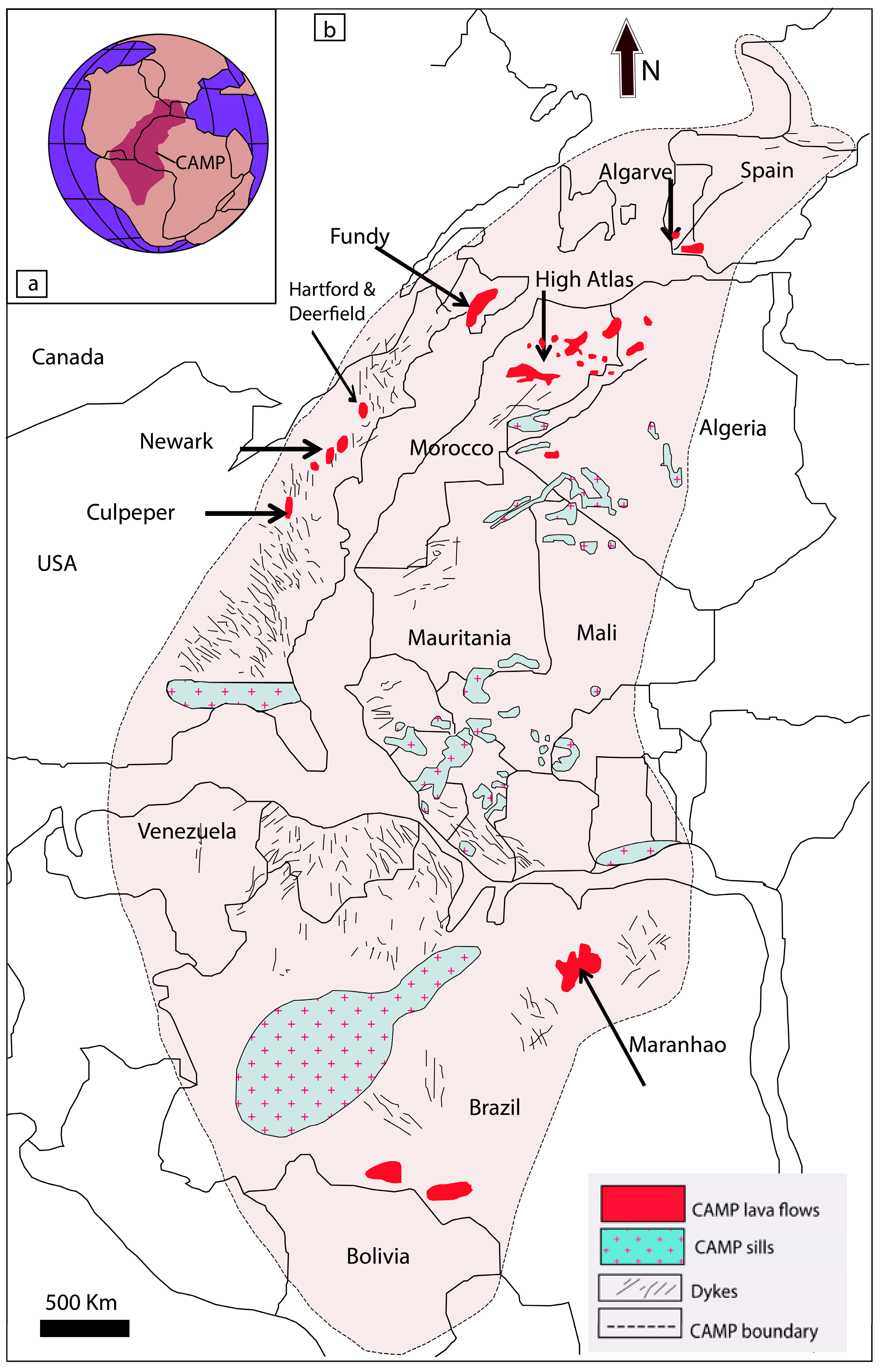
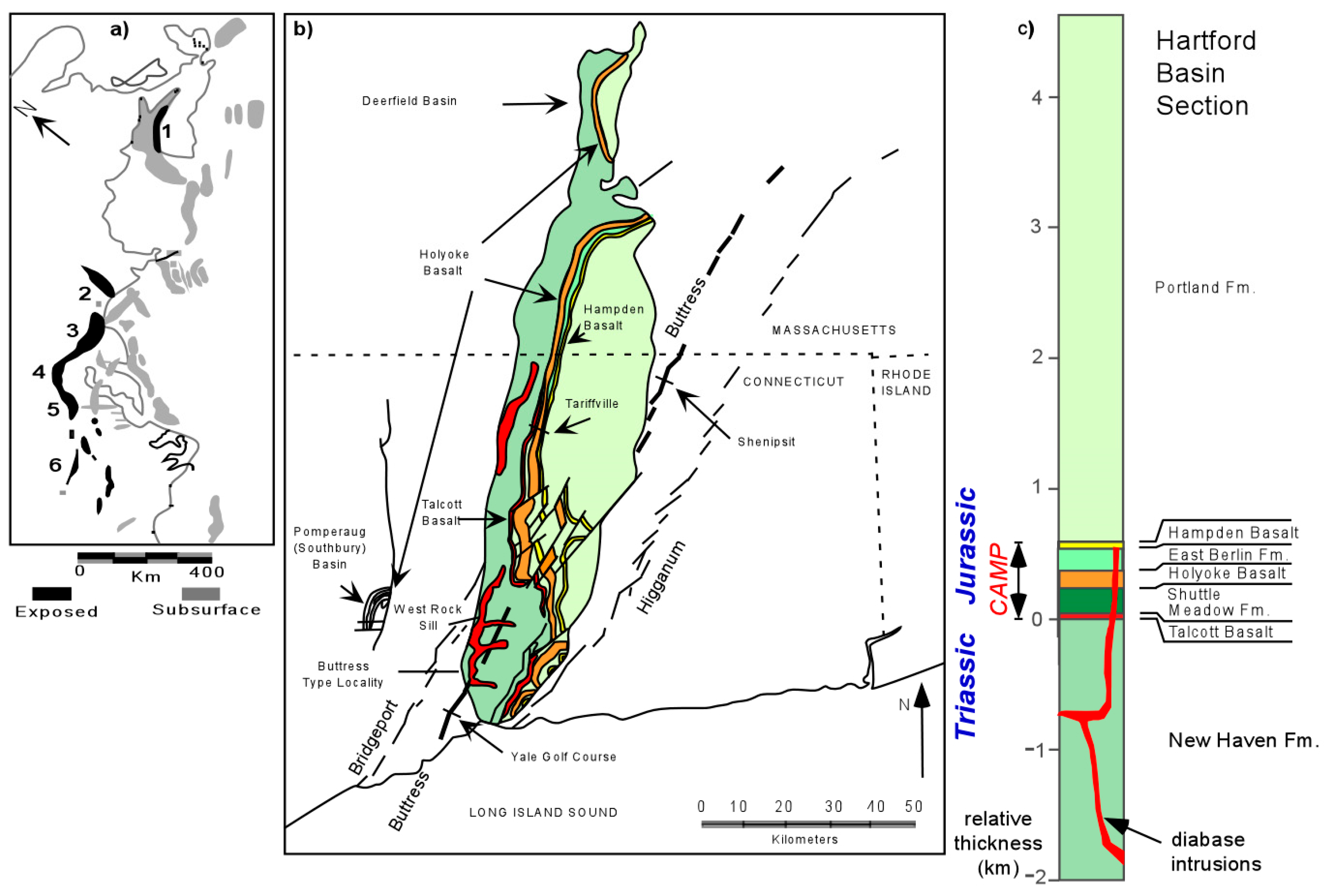
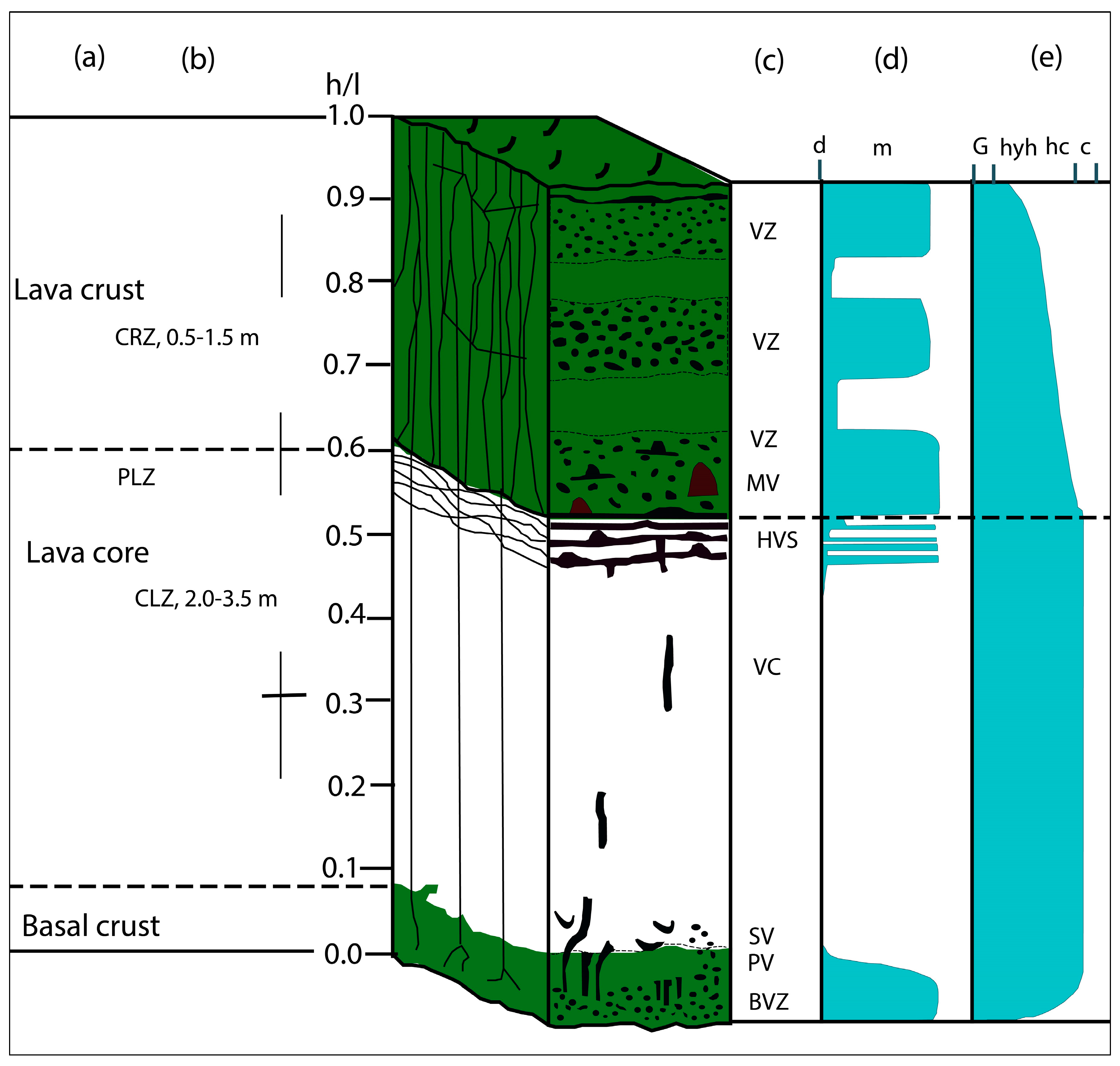
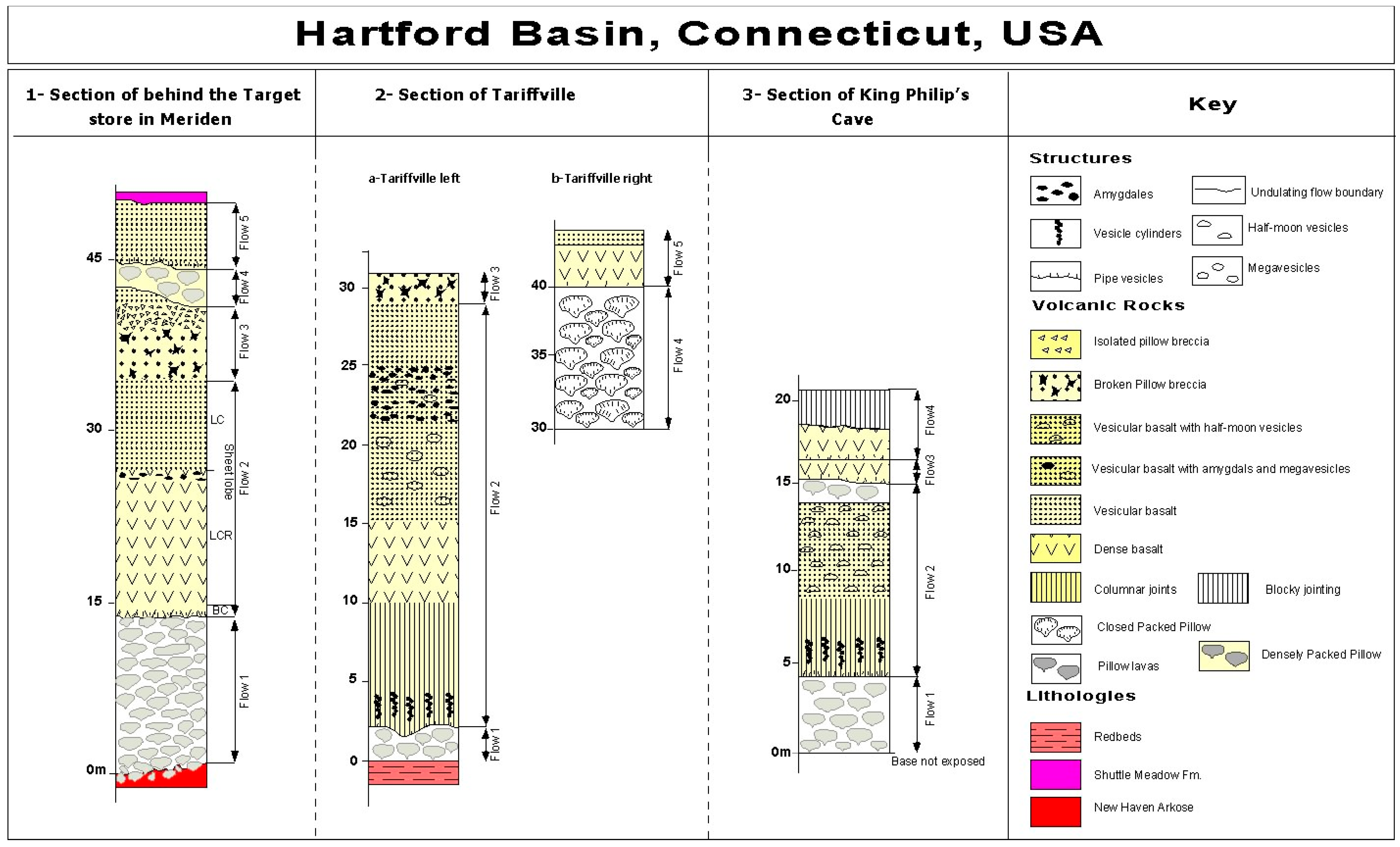
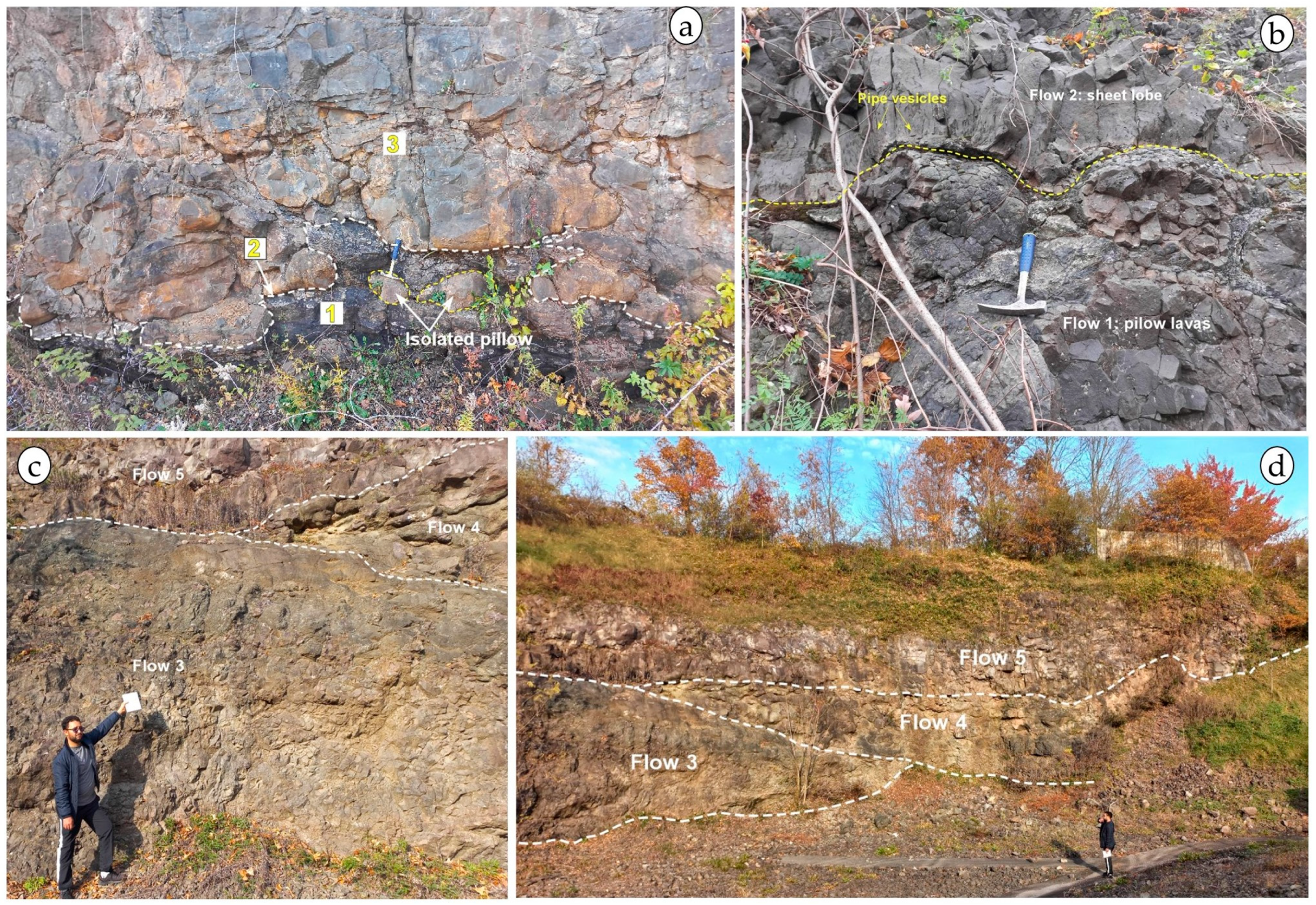
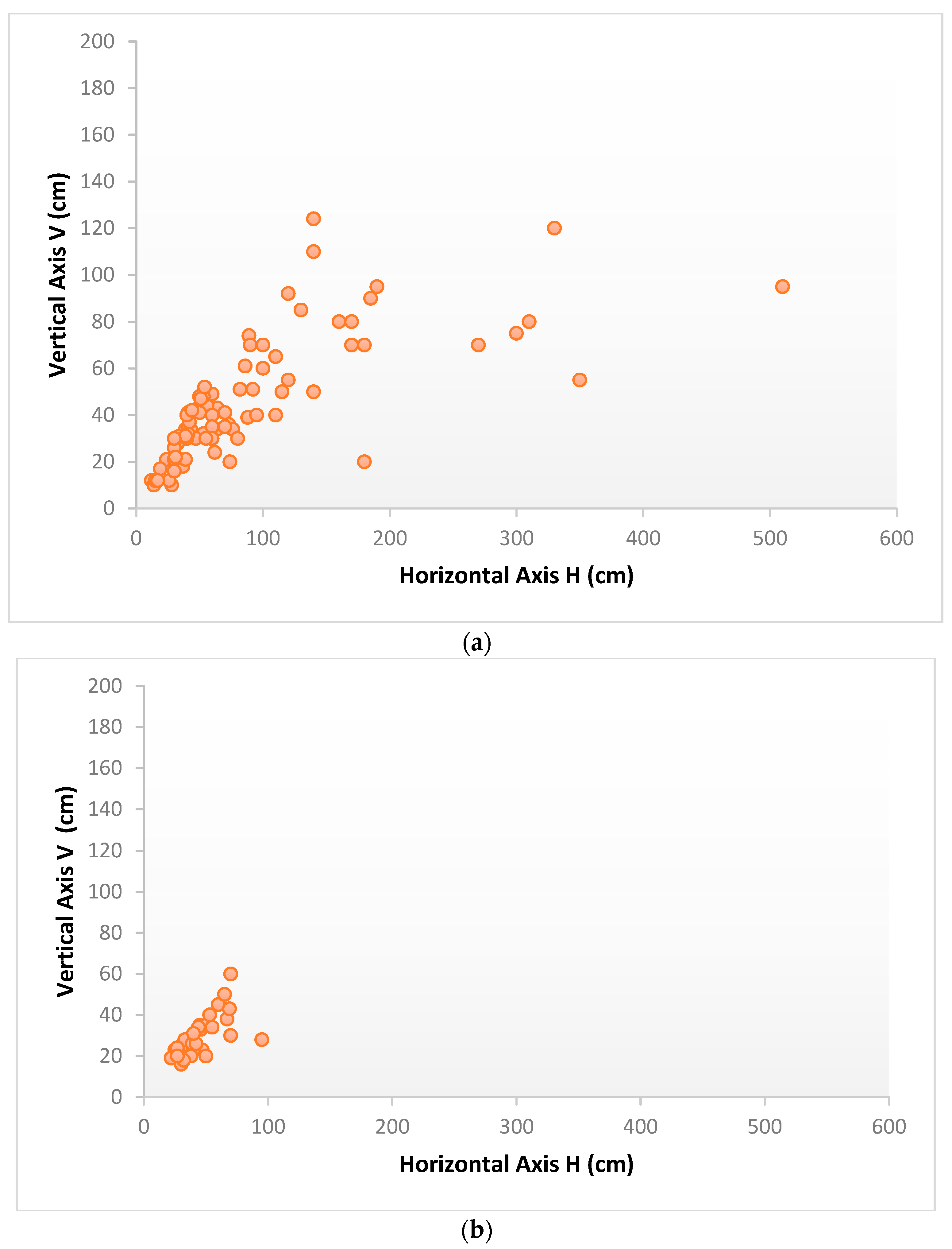
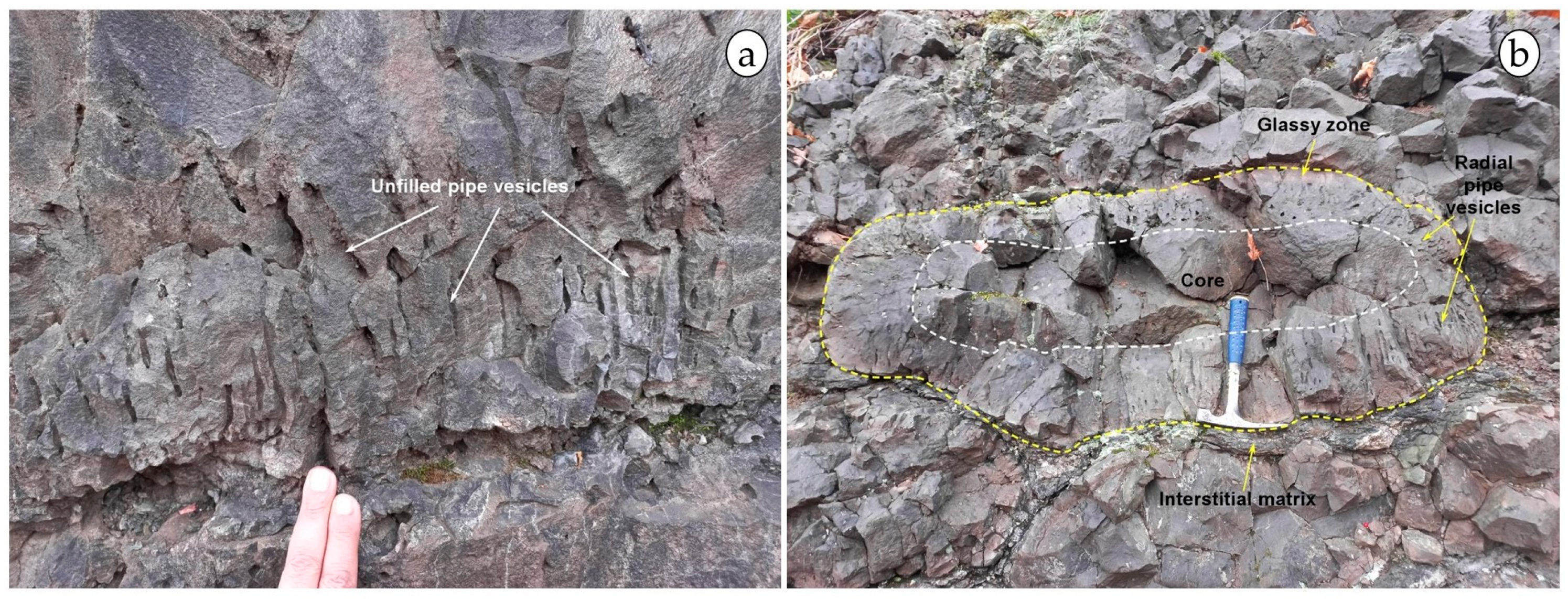

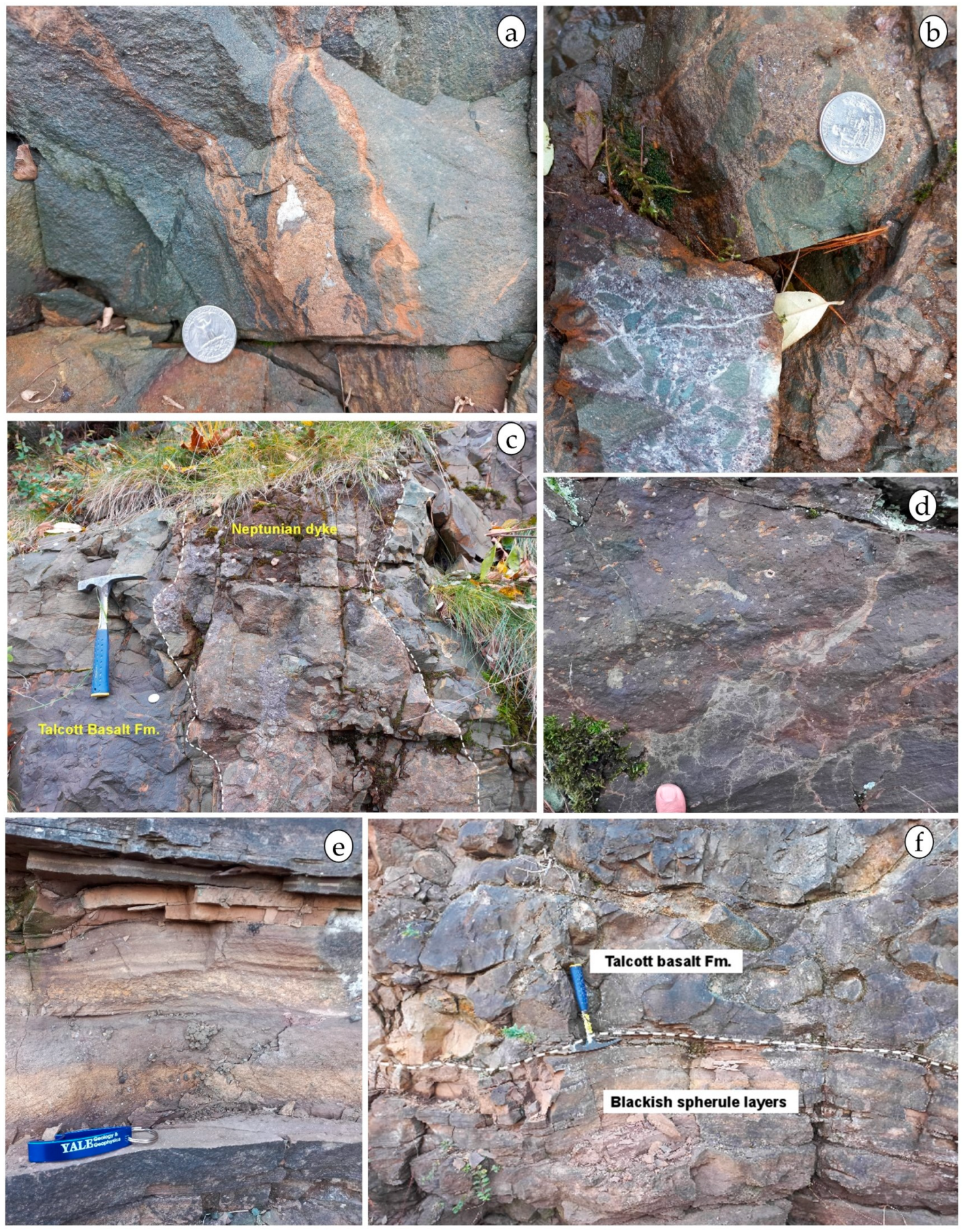


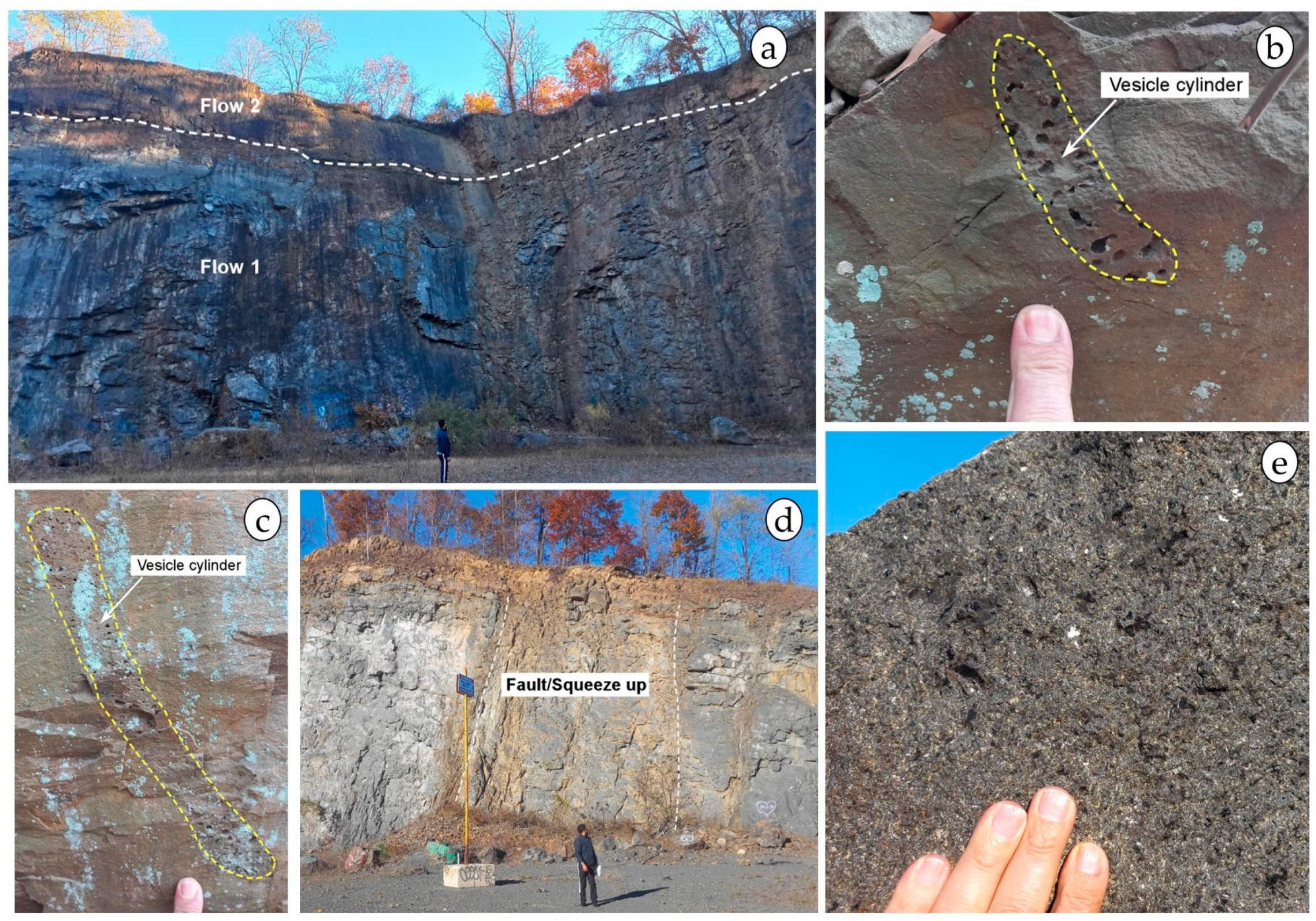

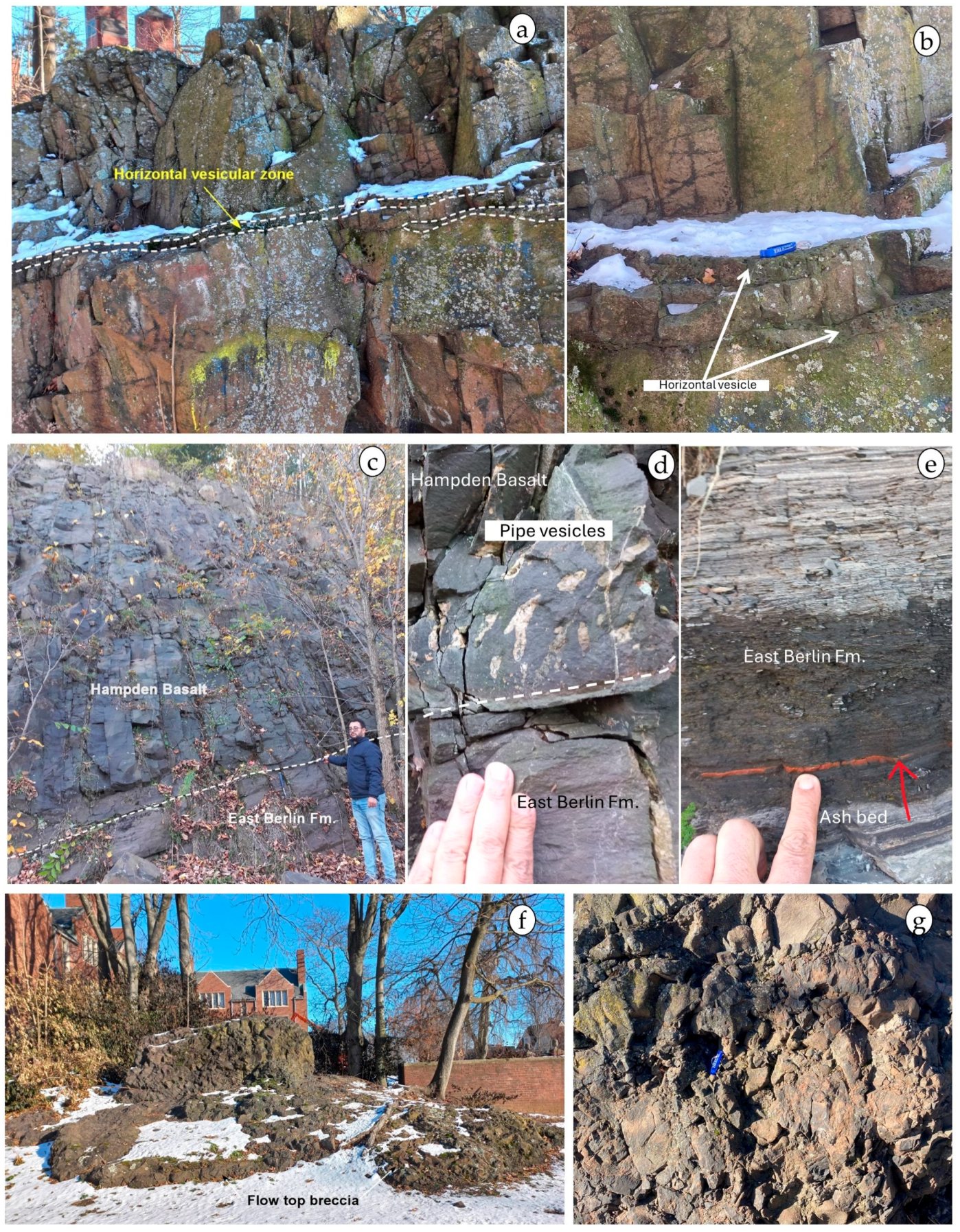
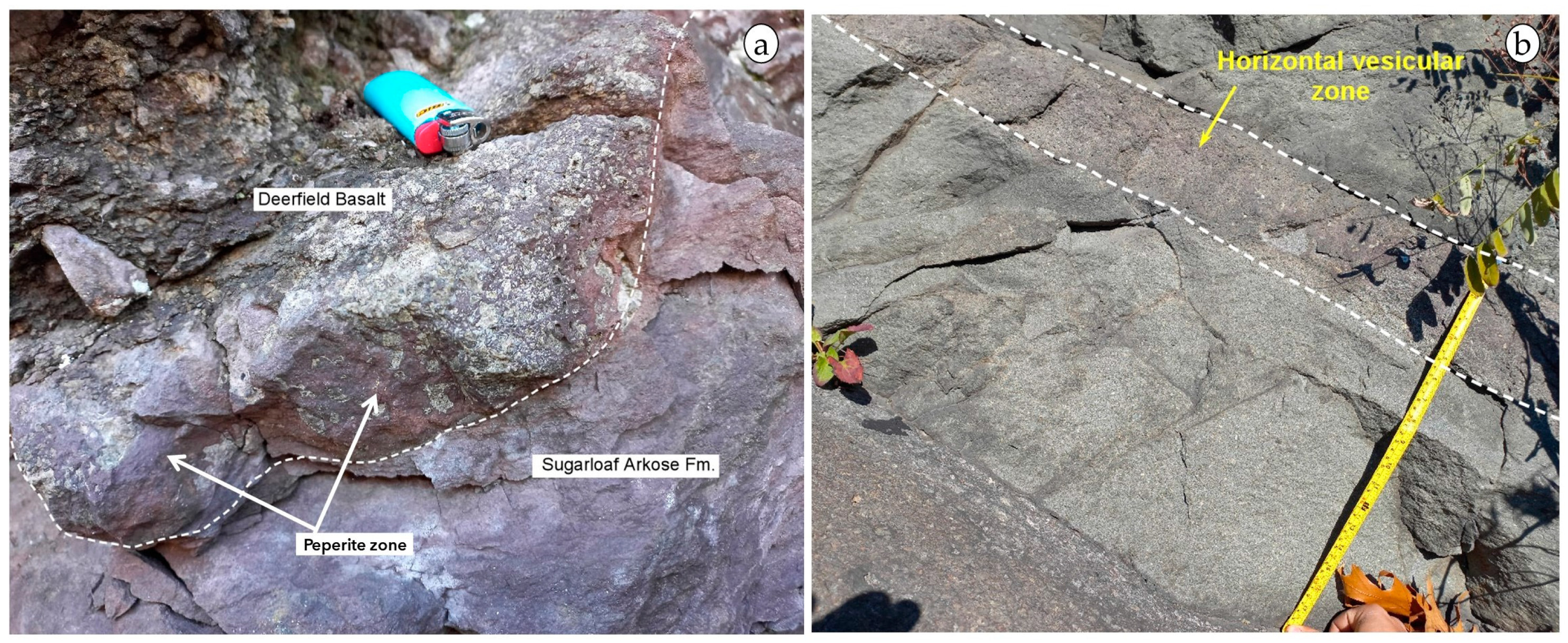
| Flow Field or Basalt Unit/Basin | Duration | Reference |
|---|---|---|
| Talcott Basalt/Hartford | 18 to 51 months | This work |
| Holyoke Basalt/Hartford | 136 years | This work |
| Hampden Basalt/Hartford | 2 months | This work |
| Deerfield basalt/Deerfield | 5 months | This work |
| Orange Mountain Basalt/Newark | 3 years | Puffer et al. (2018) [42] |
| North Mountain Basalt/Fundy | 7 days to 5 months | Kontak, (2008) [25] |
| Ait Ourir/Central High Atlas | 22 to 121 months | El Hachimi (2012) [43] |
| Argana (Alemzi South)/Argana | 0.3 to 23 months | El Hachimi (2012) [43] |
| Tiourjdal/Central High Atlas | 0.11 to 22 months | El Hachimi (2012) [44] |
| Naude’s Nek Pass/Karoo | 11 to 27 days | Jay et al. (2018) [117] |
| Palouse Falls, Ginkgo, and Sand Hollow/Pasco | 19.3, 8.3, and 16.9 years | Vye-Brown et al. (2013) [118] |
Disclaimer/Publisher’s Note: The statements, opinions and data contained in all publications are solely those of the individual author(s) and contributor(s) and not of MDPI and/or the editor(s). MDPI and/or the editor(s) disclaim responsibility for any injury to people or property resulting from any ideas, methods, instructions or products referred to in the content. |
© 2024 by the authors. Licensee MDPI, Basel, Switzerland. This article is an open access article distributed under the terms and conditions of the Creative Commons Attribution (CC BY) license (https://creativecommons.org/licenses/by/4.0/).
Share and Cite
Moumou, A.; Youbi, N.; El Hachimi, H.; El Kadiri, K.; Madeira, J.; Mata, J.; Amri, I.; Ait Baha, A. Morphology, Internal Architecture, Facies Model, and Emplacement Mechanisms of Lava Flows from the Central Atlantic Magmatic Province (CAMP) of the Hartford and Deerfield Basins (USA). Geosciences 2024, 14, 204. https://doi.org/10.3390/geosciences14080204
Moumou A, Youbi N, El Hachimi H, El Kadiri K, Madeira J, Mata J, Amri I, Ait Baha A. Morphology, Internal Architecture, Facies Model, and Emplacement Mechanisms of Lava Flows from the Central Atlantic Magmatic Province (CAMP) of the Hartford and Deerfield Basins (USA). Geosciences. 2024; 14(8):204. https://doi.org/10.3390/geosciences14080204
Chicago/Turabian StyleMoumou, Abdelhak, Nasrrddine Youbi, Hind El Hachimi, Khalil El Kadiri, José Madeira, João Mata, Isma Amri, and Abdelkarim Ait Baha. 2024. "Morphology, Internal Architecture, Facies Model, and Emplacement Mechanisms of Lava Flows from the Central Atlantic Magmatic Province (CAMP) of the Hartford and Deerfield Basins (USA)" Geosciences 14, no. 8: 204. https://doi.org/10.3390/geosciences14080204
APA StyleMoumou, A., Youbi, N., El Hachimi, H., El Kadiri, K., Madeira, J., Mata, J., Amri, I., & Ait Baha, A. (2024). Morphology, Internal Architecture, Facies Model, and Emplacement Mechanisms of Lava Flows from the Central Atlantic Magmatic Province (CAMP) of the Hartford and Deerfield Basins (USA). Geosciences, 14(8), 204. https://doi.org/10.3390/geosciences14080204








